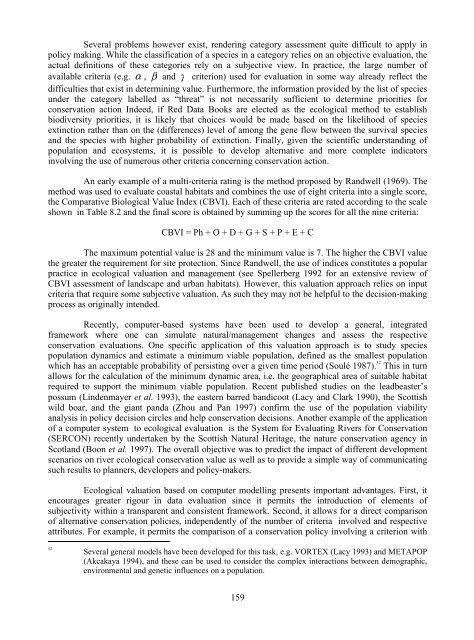Valuation of Biodiversity Benefits (OECD)
Valuation of Biodiversity Benefits (OECD)
Valuation of Biodiversity Benefits (OECD)
- No tags were found...
You also want an ePaper? Increase the reach of your titles
YUMPU automatically turns print PDFs into web optimized ePapers that Google loves.
Several problems however exist, rendering category assessment quite difficult to apply inpolicy making. While the classification <strong>of</strong> a species in a category relies on an objective evaluation, theactual definitions <strong>of</strong> these categories rely on a subjective view. In practice, the large number <strong>of</strong>available criteria (e.g. α , β and γ criterion) used for evaluation in some way already reflect thedifficulties that exist in determining value. Furthermore, the information provided by the list <strong>of</strong> speciesunder the category labelled as “threat” is not necessarily sufficient to determine priorities forconservation action Indeed, if Red Data Books are elected as the ecological method to establishbiodiversity priorities, it is likely that choices would be made based on the likelihood <strong>of</strong> speciesextinction rather than on the (differences) level <strong>of</strong> among the gene flow between the survival speciesand the species with higher probability <strong>of</strong> extinction. Finally, given the scientific understanding <strong>of</strong>population and ecosystems, it is possible to develop alternative and more complete indicatorsinvolving the use <strong>of</strong> numerous other criteria concerning conservation action.An early example <strong>of</strong> a multi-criteria rating is the method proposed by Randwell (1969). Themethod was used to evaluate coastal habitats and combines the use <strong>of</strong> eight criteria into a single score,the Comparative Biological Value Index (CBVI). Each <strong>of</strong> these criteria are rated according to the scaleshown in Table 8.2 and the final score is obtained by summing up the scores for all the nine criteria:CBVI = Ph + O + D + G + S + P + E + CThe maximum potential value is 28 and the minimum value is 7. The higher the CBVI valuethe greater the requirement for site protection. Since Randwell, the use <strong>of</strong> indices constitutes a popularpractice in ecological valuation and management (see Spellerberg 1992 for an extensive review <strong>of</strong>CBVI assessment <strong>of</strong> landscape and urban habitats). However, this valuation approach relies on inputcriteria that require some subjective valuation. As such they may not be helpful to the decision-makingprocess as originally intended.Recently, computer-based systems have been used to develop a general, integratedframework where one can simulate natural/management changes and assess the respectiveconservation evaluations. One specific application <strong>of</strong> this valuation approach is to study speciespopulation dynamics and estimate a minimum viable population, defined as the smallest populationwhich has an acceptable probability <strong>of</strong> persisting over a given time period (Soulé 1987). 52 This in turnallows for the calculation <strong>of</strong> the minimum dynamic area, i.e. the geographical area <strong>of</strong> suitable habitatrequired to support the minimum viable population. Recent published studies on the leadbeaster’spossum (Lindenmayer et al. 1993), the eastern barred bandicoot (Lacy and Clark 1990), the Scottishwild boar, and the giant panda (Zhou and Pan 1997) confirm the use <strong>of</strong> the population viabilityanalysis in policy decision circles and help conservation decisions. Another example <strong>of</strong> the application<strong>of</strong> a computer system to ecological evaluation is the System for Evaluating Rivers for Conservation(SERCON) recently undertaken by the Scottish Natural Heritage, the nature conservation agency inScotland (Boon et al. 1997). The overall objective was to predict the impact <strong>of</strong> different developmentscenarios on river ecological conservation value as well as to provide a simple way <strong>of</strong> communicatingsuch results to planners, developers and policy-makers.Ecological valuation based on computer modelling presents important advantages. First, itencourages greater rigour in data evaluation since it permits the introduction <strong>of</strong> elements <strong>of</strong>subjectivity within a transparent and consistent framework. Second, it allows for a direct comparison<strong>of</strong> alternative conservation policies, independently <strong>of</strong> the number <strong>of</strong> criteria involved and respectiveattributes. For example, it permits the comparison <strong>of</strong> a conservation policy involving a criterion with52Several general models have been developed for this task, e.g. VORTEX (Lacy 1993) and METAPOP(Akcakaya 1994), and these can be used to consider the complex interactions between demographic,environmental and genetic influences on a population.159












